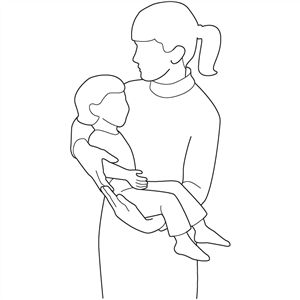Handling the Child with Cerebral Palsy: Difference between revisions
No edit summary |
No edit summary |
||
| Line 2: | Line 2: | ||
<div class="editbox"> | <div class="editbox"> | ||
=== This article is currently under development. Please come back soon to see the finished work!! === | === This article is currently under development. Please come back soon to see the finished work!! === | ||
</div> | </div> | ||
Revision as of 16:41, 17 April 2023
This article is currently under development. Please come back soon to see the finished work!![edit | edit source]
Introduction[edit | edit source]
Children with cerebral palsy have abnormal muscle tone and movement, resulting in the abnormal posture that makes it difficult for them to handle. When working with children with cerebral palsy, parents, caregivers, or therapists must be knowledgeable about handling skills. Children with cerebral palsy show atypical movements that restrict the child's ability to develop, and if the child remains in an atypical position for a long time, deformities may occur, which can lead to a permanent disability.
Handling skills are important on all interventions for cerebral palsy. Good handling facilitates more purposeful active movements for a child with cerebral palsy.
What is Handling?[edit | edit source]
Handling is the ability of a person to position, carry/hold, and move a child with cerebral palsy or other neurodevelopmental disability in such a way that his/her body achieves postural control.
It is necessary for both parents and caregivers, to have knowledge of handling children with cerebral palsy, as they stay with them almost many hours per day. Proper handling will help a child to do more purposeful activities and help the brain learn typical posture. Handling can be done using hands, or other equipment.
Effect of Handling on human body[edit | edit source]
Our body changes the position according to external sensory feedback, and this is called system sensory feedback versus feed forward control. It is necessary to observe the child, prior to handling, because any sensory feedback from hands, or equipment will result in typical or atypical movement. The knowledge on neurologic control of musculoskeletal system is necessary to master appropriate handling skills.
Importance of Appropriate Handling[edit | edit source]
Appropriate handling of a child with cerebral Palsy leads to a good posture:
- Normalization of tone or reduction of its abnormal influence on the body
- Maintenance of skeletal alignment and prevent deformities.
- Providing a stable base of support to promote functioning.
- Promoting tolerance to the desired position
- Promoting comfort and relaxation
- Facilitation of normal movement patterns or control of abnormal movement patterns
- Regulating pressure or preventing the development of pressure ulcers
- Reduction of fatigue
- Improving autonomic nervous system function (cardiac, digestive, and respiratory)
- Facilitation of maximum function with minimal pathology
- In addition, appropriate positioning facilitates eye contact, communication with the child, and social interaction.
Handling a child with Cerebral Palsy[edit | edit source]
Handling a child with Cerebral Palsy needs to take into consideration the followings:
Observing the child first:[edit | edit source]
Through Observation, the person has information on atypical movement partner, and the presentation of the child in general.
Have Knowledge about Physiopathology of Cerebral Palsy[edit | edit source]
It is very important to know why abnormal movement patterns occur in a child with cerebral palsy and what you can do to influence the near normal movement pattern. This knowledge will also help you make sense of what you observe and where to start while placing your hands through handling. It is also good to understand that you will not take away the Cerebral palsy, but you can help the child to learn and develop to their full potential and continue to leave and enjoy the life like other children without cerebral Palsy.
Feel the movement using your hands:[edit | edit source]
After observing a child, the person places the hands cautiously to feel the movement and see the reaction of the child.
Talk to the child while handling him/her[edit | edit source]
It is necessary to talk to the child while handling him/her, because physical, communicative and intellectual skills cannot be learned in isolation.
Help the child to practice![edit | edit source]
It is important to support the child to practice the skill learnt in their everyday life to master appropriate movement and posture.
Don't Remove support if the child has not yet mastered the skills[edit | edit source]
Even if the child can maintain a good posture for some time, you must understand that what you have accomplished in one session will not necessarily continue when you take your hands away. It takes time and needs to be practiced in the child's daily life.
Make it Fun![edit | edit source]
In a natural way, children learn while they are playing, it is necessary for making the handling skills playful to help the child maximize their learning in active participation.







